Ever spilled paint on your wooden gem and felt helpless? Discover the wonders and cautions of using acetone on wood! Curious? Read on!
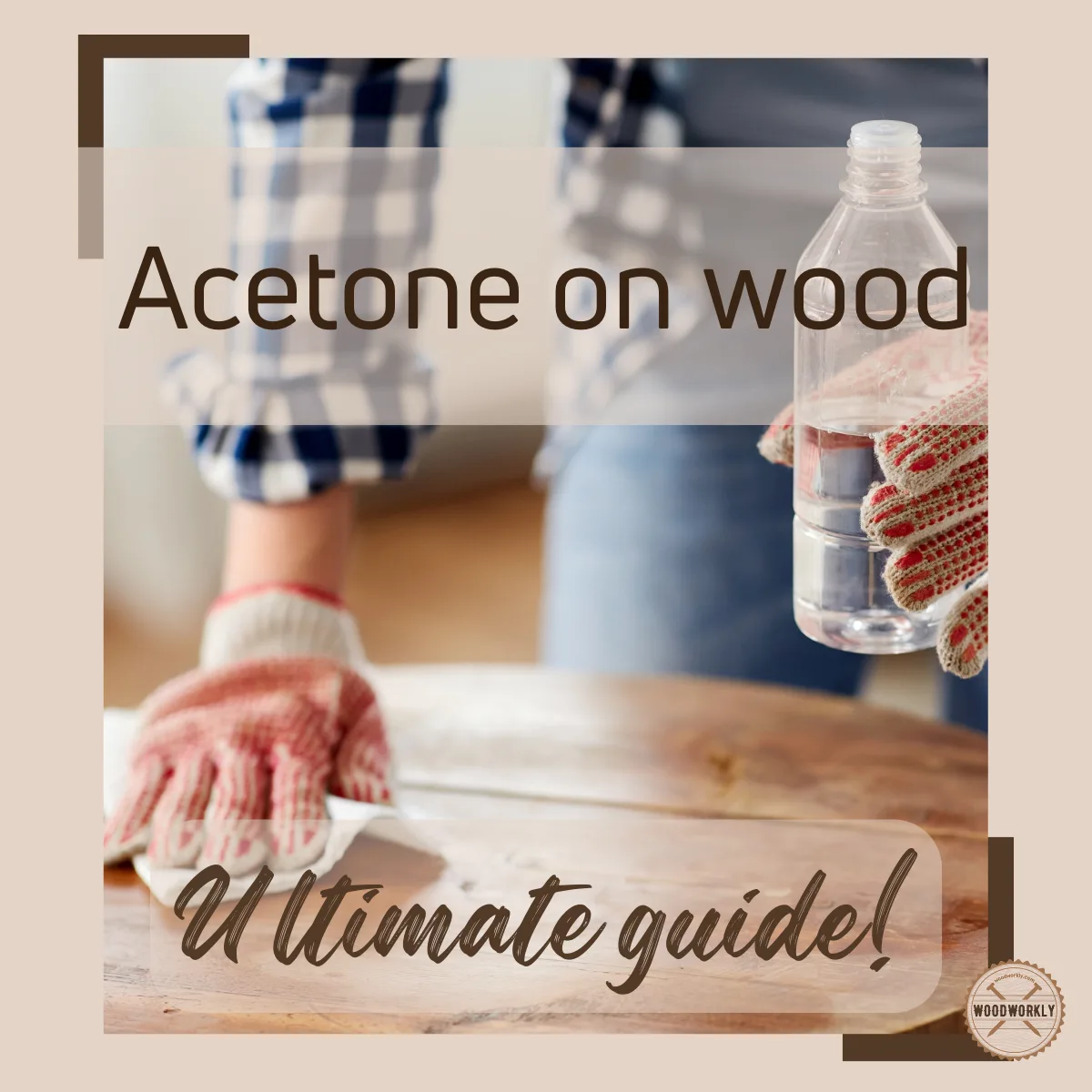
During my early wood finishing days, the biggest problem I had for a long time was not being able to find a suitable liquid to remove the stains from the wood and paint.
That’s why I researched this with the help of experts. I was able to find out about several substances, but the most commonly suggested one is acetone.
Then I tried using acetone, which is a really good material for woodworkers. That’s because acetone can do the job better than any other substance.
So, let’s find out, Can You Use Acetone on Wood?
Yes, you can use acetone on wood with no issues. Acetone can safely remove paint, varnish, and stains from wood. Apply it with a cloth in a well-ventilated area, rubbing gently on the surface. Always test on a small area to avoid potential damage. Wear protective gear to avoid skin contact or inhalation of fumes.
But there’s a lot more to know!

In this article, I’ll explore whether can you use acetone on wood and how to do that properly including expert tips and techniques.
Furthermore, I’ll answer some frequently asked questions as well.
So, let’s jump in!
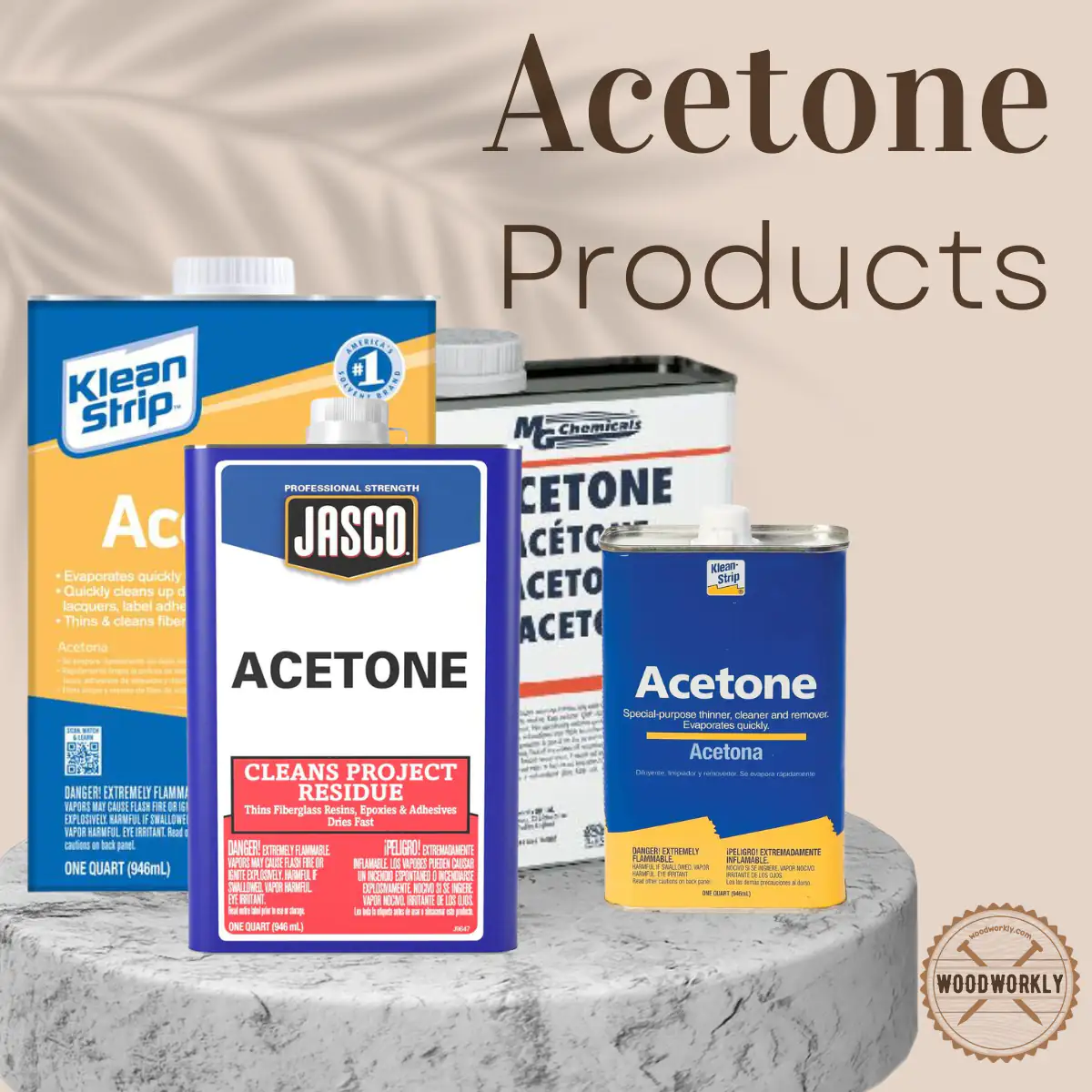
Can You Use Acetone on Woodworking?
Yes, Acetone can be used in woodworking for certain tasks. But it is a flammable substance.
So, it should be handled carefully. Some of the uses of acetone are given below.
Degreasing:
To get the final finish, oil and dirt from the original wood surface must be removed. Acetone is used extensively for this.
Removal Of Glue And Adhesives:
In some cases, there are residues like glue on the wood surface. When these are removed by pressing, the wood surface will be damaged.
For this reason, the glue, etc. can be easily removed by using acetone.
Removal Of Marker Stains:
Often in homes with small children, they use markers to draw pictures on the furniture.
Then it is quite difficult to remove the stains. So many people use acetone for this and it is quite effective.
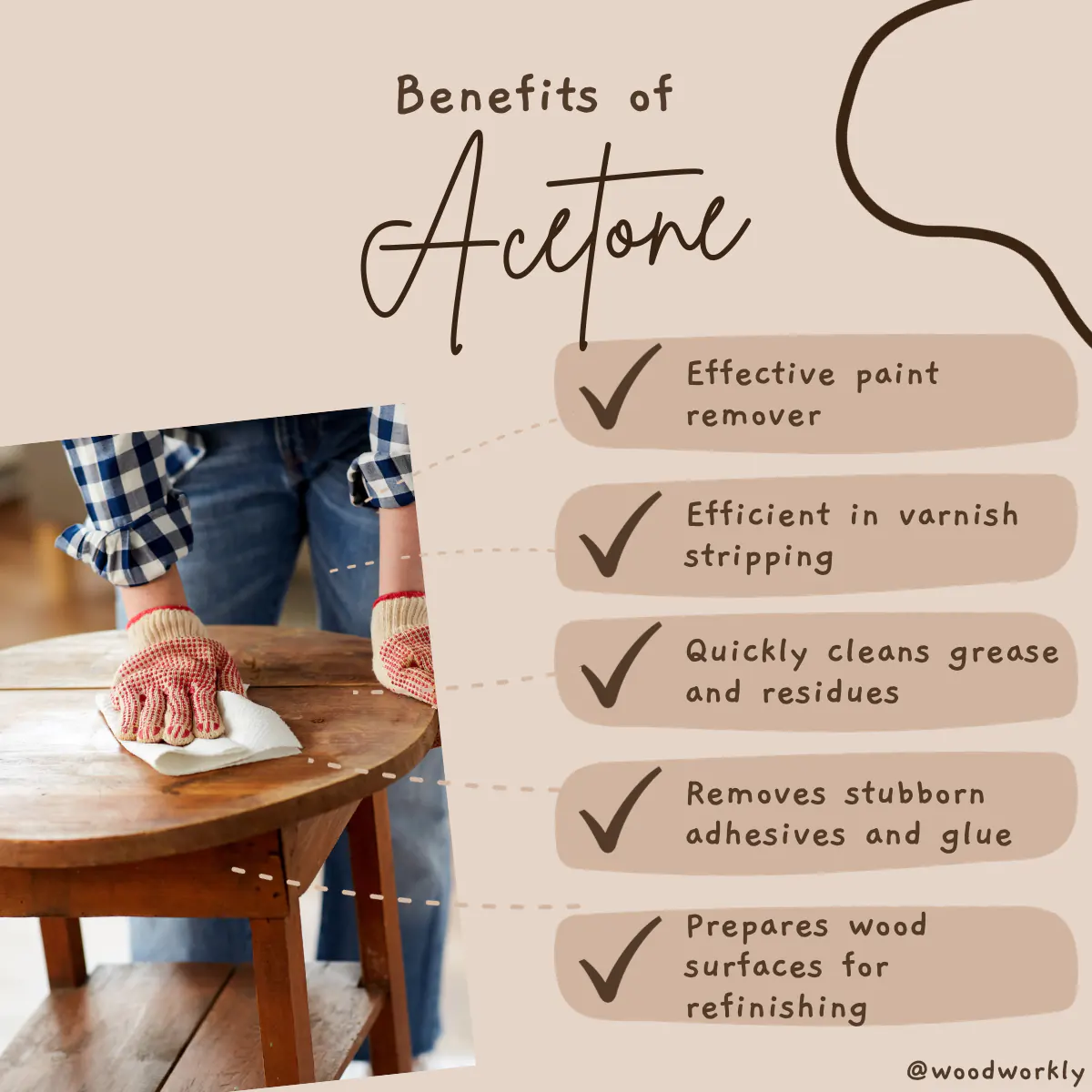
Acetone to Remove Varnish from Wood
Acetone is an excellent liquid to remove varnish from your woodwork. This is super important when wood finishing.
In my personal experience, I use acetone most of the time and I get the best final results.
Now let’s see how to use acetone on varnish and what are the steps to follow.
Acetone was applied to the varnish surface, and it interacted with the varnish. Then remove varnish on the wood surface.

This step is easy, and you can remove the varnish very quickly. But acetone is a flammable substance. You should handle with carefully.
Let’s see how it should be done!
How to Use Acetone to Remove Varnish from Wood?
Follow the below steps to remove varnish using acetone without making any mistakes.
1. Safety First
When undertaking any project, one must first take care of one’s own safety, especially when using chemicals.
Choose a well-ventilated area when using acetone. Please wear gloves, protective gear, and a respirator.
2. Check Out The Small Area
As acetone is a chemical substance, before applying it to the wood surface, it should be checked to see if it is harmful to the wood.
So first, a small inconspicuous area can be tested and used if the wood is not damaged.
3. Application Of Acetone
Take a clean cloth or rag and apply a small amount of acetone on it.
Using the clean cloth or rag that has been applied with the acetone, gently rub the surface of the varnish on the wood.
4. Wipe Off The Varnish
After wiping off the varnish with acetone, use a clean cloth to wipe the surface of the wood well.
You should repeat this step until all the varnish is removed.
5. Clean The Surface
After removing the varnish, clean the wooden surface.
So, you can use wood cleaner or other alternative method for this purpose.
6. Finishing
Once the wood is clean and free of varnish, you can apply a new finish to achieve the desired look.
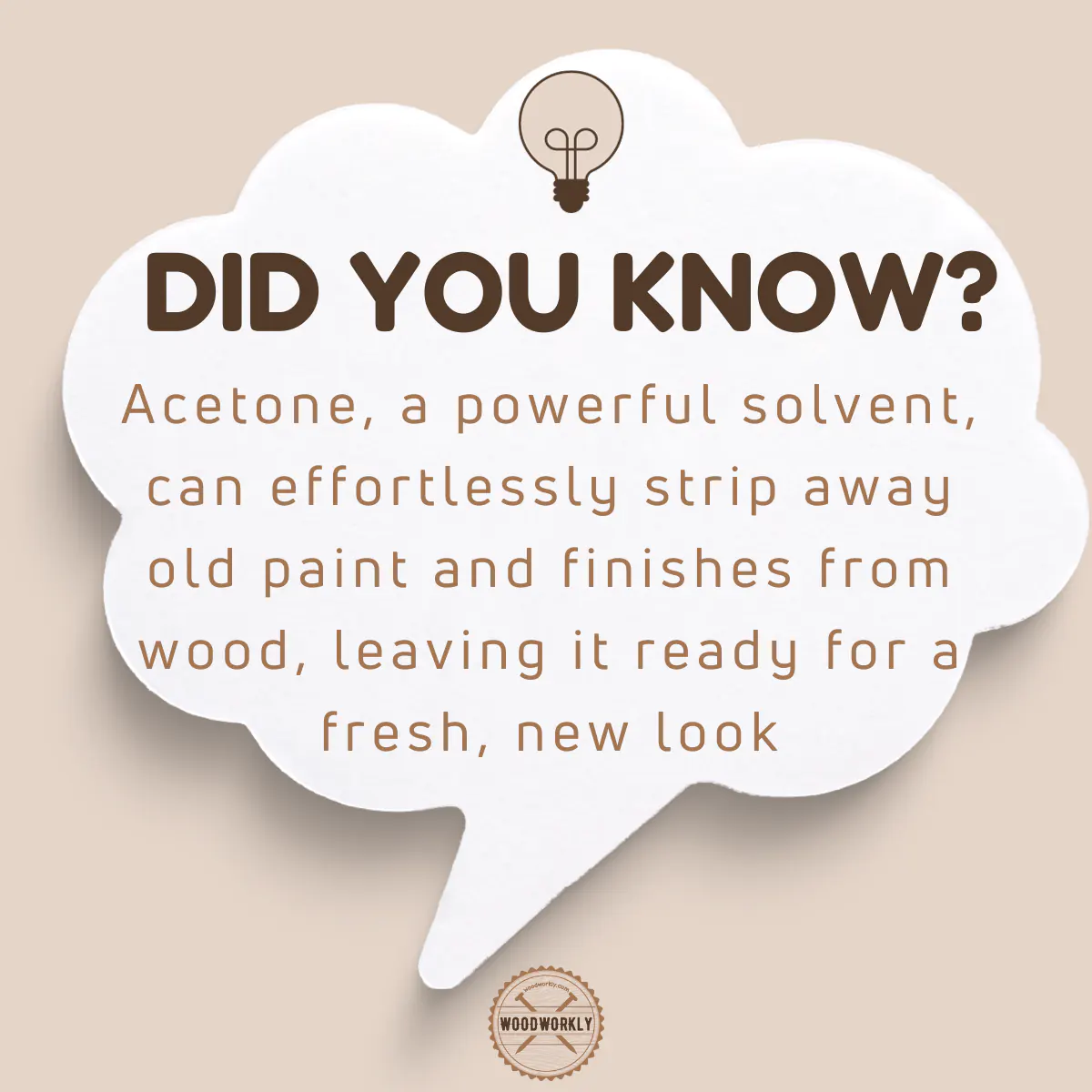
Acetone to Remove Paint from Wood
I have had many occasions to remove paint stains from the surface of wood.
Acetone can be used to remove paint on wood surfaces. Acetone has a highly solvent property. so, it can remove paint very quickly.
most people use acetone to remove the paint. Especially repairing the furniture or refinishing the wood surfaces.
but before using the acetone always test it in a small area to ensure it harms the wood.
Now let’s see how to remove ink stains with acetone and what to follow.
Does Acetone Remove Dried Paint?
Acetone can remove dried paint effectively. Because it has highly solvent properties.
So, Acetone breaks down the chemical structure and removes paint very easily.
What Kind Of Paint Does Acetone Remove?
Acetone can remove oil-based paints, enamel paints, and acrylic paints effectively. it is versatile and effective.

Let’s check out how to remove paint properly using acetone.
How to Use Acetone to Remove Paint from Wood?
Follow the below steps properly to get your furniture free of paint.
1. Safety First
When undertaking any project, one must first take care of one’s own safety, especially when using chemicals.
Choose a well-ventilated area when using acetone. Please wear gloves, protective gear, and a respirator.
2. Check Out The Small Area
As acetone is a chemical substance, before applying it to the wood surface, it should be checked to see if it is harmful to the wood.
So first, a small inconspicuous area can be tested and used if the wood is not damaged.
3. Application Of Acetone
Take a clean cloth or rag and apply a small amount of acetone on it.
Using the clean cloth or rag that has been applied with the acetone, gently rub the surface of the paint on the wood.
4. Scrape Off Paint
After using acetone use a plastic putty knife or scraper to remove the paint. But be careful about the wood surface.
5. Wipe Away Paint
After wiping off the paint with acetone, use a clean cloth to wipe the surface of the wood well.
You should repeat this step until all the paint is removed.
6. Clean The Surface
After removing the varnish, clean the wooden surface.
So, you can use wood cleaner or other alternative method for this purpose.
7. Finishing
Once the wood is clean and paint-free You can apply a new finish to achieve the desired look.
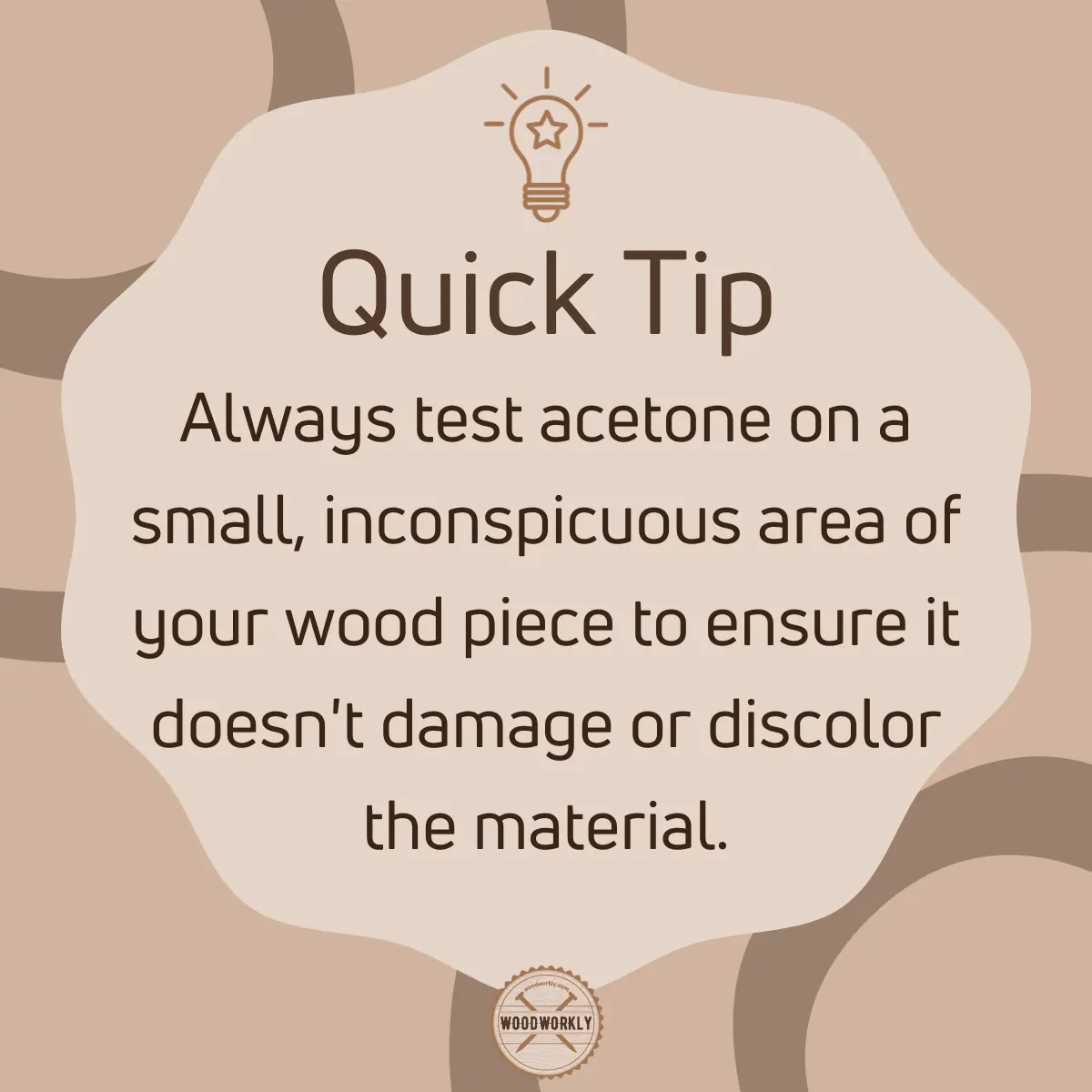
Acetone to Remove Stain from Wood
you can use acetone to remove the stain of wood. Woodworkers mostly use acetone to remove old stains and apply refinishing.
As always test in small areas and ensure it is not damaging to the wood.
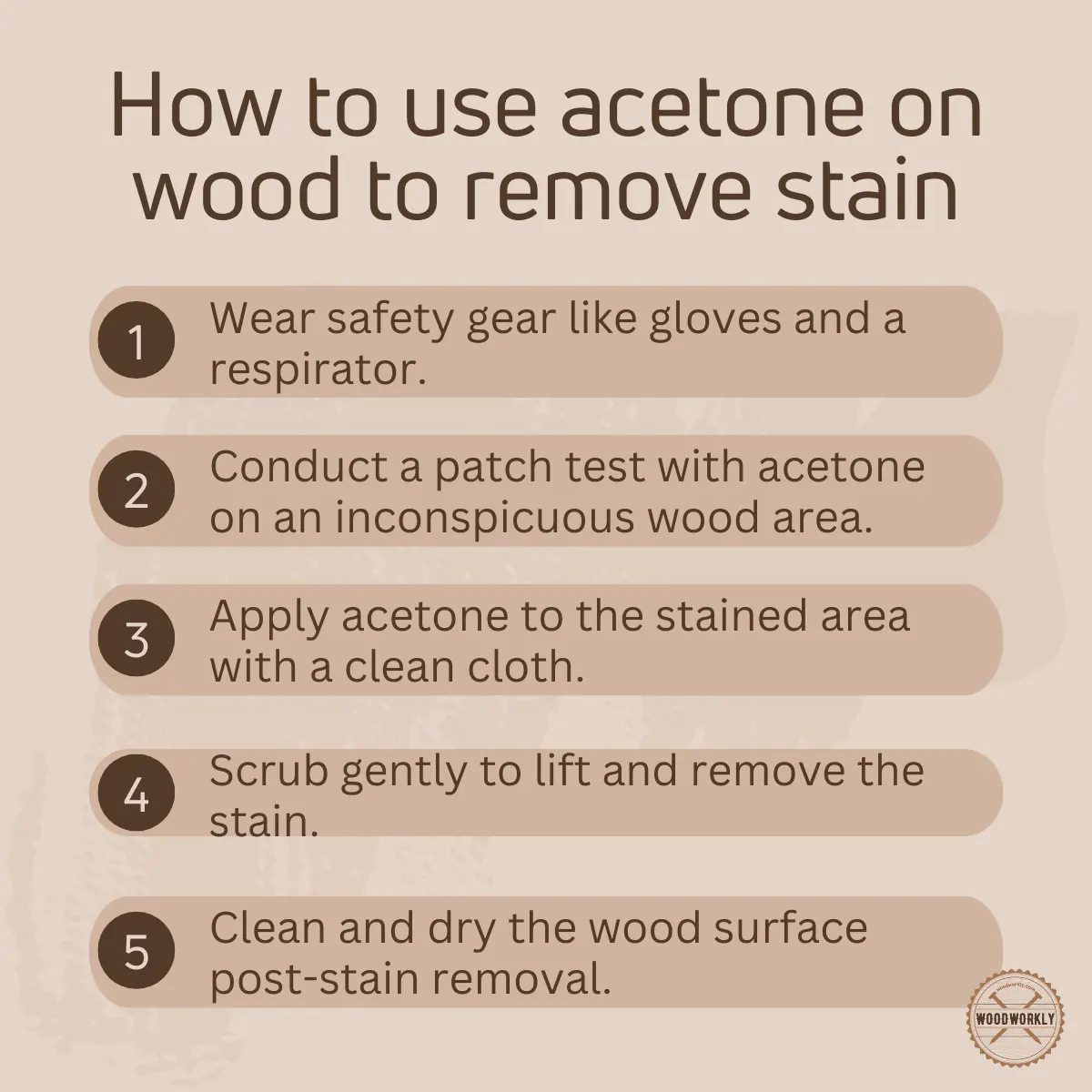
How to Use Acetone to Remove Stains from Wood
So, let’s discuss the step-by-step method of removing stains from wood using acetone.
1. Safety First
As always, first, you need to follow safety precautions. Wear goggles, and a facemask, and choose a well-ventilated area for the project.
Acetone releases a suer harsh fumes which can cause breathing issues. Therefore, working in an open area with good air circulation is must.
2. Check Out The Small Area
As acetone is a chemical substance, before applying it to the wood surface, it should be checked to see if it is harmful to the wood.
So first, a small inconspicuous area can be tested and used if the wood is not damaged.
3. Application Of Acetone
Take a clean cloth or rag and apply a small amount of acetone on it.
Using the clean cloth or rag that has been applied with the acetone, gently rub the surface of the paint on the wood.
4. Scrab And Remove Stains
After using acetone, you can use a scrubbing pad or a brush to scrub away the stained areas.
But you should know to use scrub not to damage a wood surface.
5. Repeating
You may need to process it again and again several times until the removed stains are.
6. Clean The Surface
After removing the varnish, clean the wooden surface. So, you can use wood cleaner or other alternative method for this purpose.
7. Finishing
Once the wood is clean and stain-free You can apply a new finish to achieve the desired look.

Acetone to Clean Wood After Sanding
Acetone can be used to clean the wood after sanding. It can remove dust and debris more effectively.
Make sure the wood is free of sawdust after sanding. If there’s any sawdust, that can be a trouble.
You can remove sawdust using a clean tack cloth or dust collection pipe system. The collected sawdust can be dried out and used as fertilizer.

If You need to get a clean final finish You can use acetone.
How to Use Acetone to Clean Wood After Sanding
Let’s discuss each and every step you should follow when cleaning wood with acetone after sanding the wood.
1. Safety First
When undertaking any project, one must first take care of one’s own safety, especially when using chemicals.
Choose a well-ventilated area when using acetone. Please wear gloves, protective gear, and a respirator.
2. Check Out The Small Area
As acetone is a chemical substance, before applying it to the wood surface, it should be checked to see if it is harmful to the wood.
So first, a small inconspicuous area can be tested and used if the wood is not damaged.
3. Application Of Acetone
Take a clean cloth or rag and apply a small amount of acetone on it.
Using the clean cloth or rag that has been applied with the acetone, gently rub the surface of the sanding on the wood.
4. Wipe Down The Surface
wipe down the sanded wood surface with the acetone-dampened cloth. This will help remove fine dust and particles that may have settled on the wood.
5. Repeating
You may need to process it again and again several times until the remove sanding is done.
6. Clean The Surface
After removing the varnish, clean the wooden surface. So, you can use wood cleaner or other alternative method for this purpose.
7. Finishing
Once the wood is clean and stain-free You can apply a new finish to achieve the desired look.

Tips for Using Acetone on Wood
Now I’m going to share with you several tips that I use when working with acetone to get pretty good results.
Some of the below tips were gathered from experts that I’ve interviewed when searching for information about acetone.
The below tips will definitely take your knowledge about acetone to the next level.
Just keep reading!
Check A Small Area
Care must be taken when applying chemicals to wood surfaces. Before applying acetone to a large surface, test using acetone on a small, inconspicuous area.
This is because some wood is damaged when the chemical is applied, so be sure to use acetone on a small, inconspicuous area and start applying acetone.
Ventilation Is Very Important
When using chemicals, work in a well-ventilated area to avoid inhaling fumes.
Therefore, always be careful to choose a well-ventilated area when using acetone.
Wear Protective Gear
Wear gloves and a respirator to protect the skin and respiratory system.
This can prevent possible accidents.
Avoid Open Flames
Substances such as acetone are highly flammable and should be kept away from fire or heat sources.
Clean Tools Thoroughly
If brushes or cloths are used to apply acetone, wash thoroughly after use to avoid damaging them.
That’s it, folks! Now you know if can you use acetone on wood and how to do that properly without making any mistakes like a pro!
Since you already know about using acetone properly, you should also have good knowledge about the removal of acetone from wood as well. That’s how you can gain good experience.

So, let’s answer some frequently asked questions.
FAQs
Is it safe to use acetone on wood?
Yes, acetone can be safely used on wood to remove finishes like paint, varnish, and stains when handled with care. However, always test it on a small, inconspicuous area first as it can potentially damage certain types of wood and finishes.
Does acetone damage the wood’s finish?
Acetone can strip the finish from wood, including paint, varnish, and stains. However, if applied to bare wood, it typically doesn’t cause damage, though it might raise the grain slightly due to its rapid evaporation rate.
How should I use acetone to remove varnish from wood?
Apply a small amount of acetone to a clean cloth and rub it gently onto the varnished wood surface. Always work in a well-ventilated area and wear appropriate safety gear to protect yourself from the fumes.
Can acetone be used to clean wood after sanding?
Yes, acetone is effective for cleaning wood surfaces after sanding. It helps in removing residual dust and debris, ensuring a cleaner surface for the application of finishes.
Will acetone remove wood stains?
Acetone is effective in removing wood stains. However, like with other finishes, it should be tested on a small area first to ensure it does not damage the wood.
Is acetone flammable and what precautions should be taken while using it?
Acetone is highly flammable; hence, it should be used with caution. Avoid open flames and work in well-ventilated areas while wearing protective gear to safeguard against inhaling fumes or skin contact.
Can acetone be used to remove paint from wood?
Acetone effectively removes both fresh and dried paint from wood. However, a patch test on a hidden area is recommended to ensure it doesn’t damage the wood or the desired finish.
Does acetone remove polyurethane finishes from wood?
Acetone can soften and remove polyurethane finishes. However, precaution is advised to prevent potential damage to the wood surface underneath.
Can I use acetone to clean wood before refinishing?
Yes, acetone can be used to clean wood surfaces before refinishing. It effectively removes grease, wax, and old finishes preparing the wood for a new coat.
How to neutralize or clean up after using acetone on wood?
Acetone evaporates quickly, so typically airing out the area or wiping the surface clean is sufficient. Ensure the area is well-ventilated during and after the application to dispel fumes.
DId I cover all you wanted to know about: Can You Use Acetone on Wood
In this article, I’ve deeply discussed whether can you use acetone on wood and how to use acetone for cleaning, and removing paints and stains properly including expert tips.
Acetone is a commonly used substance in woodworking. Acetone is mainly used to remove varnish, paint, and stains. It can remove old finishes. So, it is most popular among woodworkers. But acetone is a flammable substance. So, it has the potential to damage certain types of wood. However, it is crucial to handle acetone with care.
Furthermore, I’ve answered some frequently asked questions as well.
Hope you’ve learned all you wanted to know about using acetone on wood correctly without messing up your project.
Now its time for you to do the homework and use acetone especially for your wood finishing projects to see how it behaves in practical scenarios. Make sure to test on a small area first!